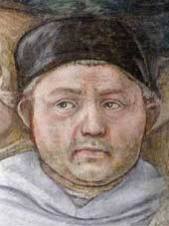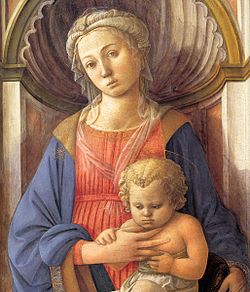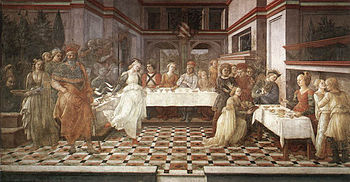Art Principles in Lippi Madonna and Child With Angels
| Madonna and Kid (Lippina) | |
|---|---|
 | |
| Artist | Filippo Lippi |
| Twelvemonth | c. 1450–1465 |
| Medium | Tempera on panel |
| Dimensions | 92 cm × 63.5 cm (36 in × 25.0 in) |
| Location | Uffizi Gallery, Florence |
Madonna with Child (Italian: Madonna col Bambino eastward angeli or Lippina) is a painting by the Italian Renaissance artist Filippo Lippi. The engagement in which information technology was executed is unknown, just most art historians concur that information technology was painted during the final role of Lippi's career, between 1450 and 1465.[1] [ii] [three] [iv] Information technology is i of the few works by Lippi which was not executed with the help of his workshop and was an influential model for later depictions of the Madonna and Kid, including those by Sandro Botticelli. The painting is housed in the Uffizi Gallery, Florence, Italy, and is therefore unremarkably called "The Uffizi Madonna" amidst art historians.[iii] [4] [5]
Background [edit]

A self-portrait of Fra Filippo Lippi.
Fra Filippo was born in 1406 in Florence to a poor family unit where his father was a butcher. He entered a monastery with his brother at an early age. Later in his life, he was moved to a monastery in Prato, and hither vicious in honey with a nun, Lucrezia Buti, with whom he had ii children. He encountered more than trouble when his patrons claimed that Fra Filippo did non fulfill his contracts. Fra Filippo's main patrons were the Medicis.[1]
History [edit]
The committee and the exact execution date of the painting are unknown. In 1457, Giovanni de' Medici wished to souvenir a panel to the King of Naples and deputed Fra Filippo to paint it. Fra Filippo, who was working in Prato at that time, decided to temporarily return to his residence in Florence to work on this project. Fra Filippo wrote letters to Giovanni that show that the painter abandoned the project because of a lack of funding. Although fine art historian Ulmann believes that Fra Filippo presented the Uffizi Madonna to Giovanni to thank him for acting every bit an intermediary between him and the King of Naples, Edward C. Strutt states that this belief is incorrect. All the same, he also states that the Uffizi Madonna was in all probability executed around this fourth dimension, while Fra Filippo was staying in Florence. This is likewise demonstrated by the techniques that Fra Filippo used to realize this painting: the edgeless execution and the bold colors highlight how the painter was influenced by the technique of fresco painting. Since he acquired such techniques past working at the Prato Cathedral, long earlier he moved to Florence, Strutt believes that Fra Filippo must have executed this painting after his time working at the Cathedral.[iii]
The Madonna is traditionally identified with Lucrezia Buti, as for most of Fra Filippo's Madonnas.[1] [v] [6]
Some other possible interpretation of the painting is that the unusual size is perhaps continued to a personal event, such as the nativity of his son, Filippino (1457): however, if Filippino was called as model for the angel in the foreground, the panel could be from a engagement as belatedly every bit around 1465.[7]
An 18th-century inscription in the rear of the panel testifies the presence of the painting in the Medici Villa del Poggio Imperiale at the time. On 13 May 1796 information technology entered the Gran Ducal collections in Florence, which formed the base of operations of the future Uffizi museum.[three]
Description [edit]

The Uffizi Madonna is associated with the taste of the new age, as the Madonna is "lovelier and more fashionable than whatsoever of Filippo'southward earlier Madonnas".[i] The group of Madonna and Child is, unusually for the menstruation, placed in front of an open window across which is a landscape inspired to Flemish painting.[7] The Madonna sits on a chair, at the window of a business firm located on a hilltop, which offers a view of an elaborate landscape of "plains, distant mountains, a city and a bay". Her eyes are pointed down and her easily are folded in prayers earlier kid Jesus, who is held upwards to her by ii angels. She is wearing an elaborate coiffure with a soft veil and pearls: these elements, forth with her costume, stand for the elegance of the mid-1400s and were re-used in numerous late 15th century works in Florence.[one] Furthermore, as in many Renaissance paintings, the Madonna's hair is shaved farther back because, "the forehead [was] an object of special beauty" that resembled "a glowing, beautifully set pearl".[i]

Fra Filippo's Madonna with the Kid and Scenes from the Life of St Anne, also known every bit the Pitti tondo. Information technology is closely related to the Uffizi Madonna.
This Madonna resembles other Madonnas from the same artist. For case, it is closely related to Fra Filippo'south Pitti tondo Madonna, simply it lacks "the pathetic girlish loveliness" of the Pitti tondo and rather has "a more womanly and mature type of dazzler".[vi]
The affections on the correct is one of the most curious parts of the painting: he is looking at the viewer with a "roguish grin, more expressive of mischief than of seraphic perfection".[3] His pose does not resemble that of an angel, and he does not seem to be playing his role, rather he seems to exist the real child.[six]
Technique [edit]
The big window placed behind the Madonna helps reducing the gap between the viewer and the figures, which are also very shut to the plane to assist in making the viewer experience office of the painting.[2]
Fra Filippo'south fresco groundwork from his time in Prato influences this painting from the coloring and the inattention to details. The colors are practical in bold strokes, that nearly expect contained from each other, which shows that Fra Filippo was "taking very little trouble to ensure harmonious blending of the various tints", which is a characteristic of frescoes. The limerick of the painting is of pyramidal shape, and the foreground and background are arranged in a way that suggest that Fra Filippo was also influenced by the methods of Donatello's school.[3]

From his earlier paintings, it is axiomatic that Fra Filippo was influenced by Masaccio.[8] Nevertheless, Masaccio'southward chiaroscuro has disappeared in the Uffizi Madonna, and figures are at present illuminated by a soft glow with harsh shadows. This greatly reduces the sense of volume that was peculiar in Fra Filippo'southward earlier paintings.[1]
Symbolism [edit]
This painting contains religious symbols: there are rocks and the seashore exterior the window, which are recurrent themes in Florentine Renaissance paintings. The seashore probably alludes to the Virgin Mary's championship "star of the sea and port of our conservancy", and the rocks allude to the tales of prophet Daniel.[one]
Interpretation [edit]
| External video | |
|---|---|
 | |
| |
The angel on the right has always been of item importance to art historians. Marylin Lavin argues that the Uffizi Madonna "should exist understood as a representation of the marriage of Christ and the Virgin Mary". Co-ordinate to Barnaby Nygren, the fact that the Madonna is not holding the kid, merely rather he is being presented to her argues Lavin's interpretation. Still, Bernard Berenson argues that "the relationship between bride and groom is non every bit the Virgin Mary and Christ but rather equally the individual devout soul and God".[four] Finally, Jonathan Jones argues that the Madonna is "1 of the most beautiful paintings of the Renaissance" and an exemplification of the humanizing of faith that dates dorsum to Giotto. According to him, Fra Filippo, with this painting, makes the relation between the Madonna and the kid that of a existent mother and baby.[6]
References [edit]
- ^ a b c d e f g h Hartt, Fredrick. History of Italian Renaissance Art. Englewood Cliffs, North.J, and New York: Prentice-Hall, Inc. and Harry North. Abram, Inc.
- ^ a b Nygren, Barnaby. "Una cosa che non e': Perspective and Humour in the Paintings of Flippo Lippi". Oxford Art.
- ^ a b c d e f Strutt, Edward (1901). Fra Filippo Lippi. London: George Bell and Sons.
- ^ a b c Nygren, Barnaby (Fall 2008). "A FRIEND OF THE GROOM OR A LOVER OF THE BRIDE?: THE CUCKOLDING ANGEL IN FILIPPO LIPPI'Southward "UFFIZI MADONNA"". Notes in the History of Art. 28 (ane). JSTOR 23207967.
- ^ a b "Madonna with Kid and ii Angels by Filippo Lippi".
- ^ a b c d Jones, Jonathan. "Madonna With Child and Two Angles, Filippo Lippi". The Guardian . Retrieved 2015-10-thirty .
- ^ a b c "Fra Filippo Lippi". Smarthistory at Khan Academy. Retrieved March 14, 2013.
- ^ Berenson, Bernard (1959). The Italian Painters of the Renaissance. Cromwell Place, London: The Phaidon Press.
Sources [edit]
- Berenson, Bernard (1959). The Italian Painters of the Renaissance. Cromwell Place, London: The Phaidon Press.
- Fossi, Gloria (2004). Uffizi. Florence: Giunti.
- Hartt, Fredrick. History of Italian Renaissance Fine art . Englewood Cliffs, N.J, and New York: Prentice-Hall, Inc. and Harry N. Abram, Inc.
- Jones, Jonathan. "Madonna With Child and 2 Angels, Filippo Lippi". The Guardian . Retrieved 2015-ten-30 .
- Nygren, Barnaby (Fall 2008). "A FRIEND OF THE GROOM OR A LOVER OF THE BRIDE?: THE CUCKOLDING ANGEL IN FILIPPO LIPPI'Southward "UFFIZI MADONNA"". Notes in the History of Art. 28 (i). JSTOR 23207967.
- Nygren, Barnaby. "Una cosa che non e': Perspective and Humour in the Paintings of Flippo Lippi". Oxford Art.
- "Madonna with Kid and two Angels by Filippo Lippi".
- Strutt, Edward (1901). Fra Filippo Lippi. London: George Bell and Sons.
External links [edit]
- High resolution image at Google Art
- A description of Madonna and Child from The World's Famous Pictures by Martin Conway and Charles J. Holmes
Source: https://en.wikipedia.org/wiki/Madonna_and_Child_(Lippi)
Post a Comment for "Art Principles in Lippi Madonna and Child With Angels"